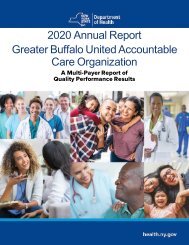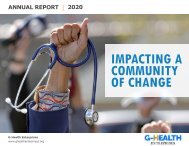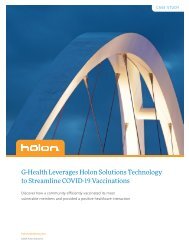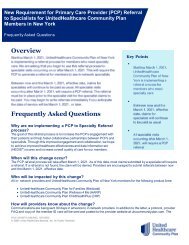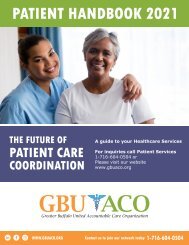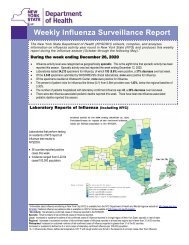Future of Health Care 2020
- No tags were found...
You also want an ePaper? Increase the reach of your titles
YUMPU automatically turns print PDFs into web optimized ePapers that Google loves.
Payments and<br />
Reimbursements<br />
THE FUTURE OF HEALTH CARE // PATIENT CARE<br />
Sponsored by<br />
SCRAMBLING<br />
FOR FUNDS<br />
Elizabeth Woike-Ganga<br />
<strong>of</strong> BestSelf Behavioral<br />
<strong>Health</strong>: “The DSRIP<br />
funding really allowed<br />
us to implement some<br />
innovative, out-<strong>of</strong>-thebox<br />
solutions to keep<br />
people out <strong>of</strong> the ER and<br />
the hospital, and we did<br />
that really successfully.”<br />
JOED VIERA<br />
END OF $335M MEDICAID REFORM PROGRAM CHALLENGES PROVIDERS<br />
BY TRACEY DRURY<br />
tdrury@bizjournals.com<br />
For the last five years, area health-care<br />
providers have been developing programs<br />
and innovations to cut emergency-room<br />
visits and unnecessary hospital<br />
readmissions, thanks to $335 million<br />
in federal dollars for Medicaid reforms.<br />
March 31 was the <strong>of</strong>ficial end to the<br />
Delivery System Reform Incentive Payment<br />
(DSRIP) program, leaving providers<br />
to figure out how to continue programs or<br />
find resources and grant funding to keep<br />
staffers in new or adjusted roles.<br />
The federal waiver, initially approved<br />
in 2014, brought $8 billion into the state,<br />
with $335 million distributed in Western<br />
New York through the Millennium Collaborative<br />
<strong>Care</strong> system — led by Erie County<br />
Medical Center — and Community Partners<br />
<strong>of</strong> Western New York — led by Catholic<br />
<strong>Health</strong>’s Sisters <strong>of</strong> Charity Hospital.<br />
The two organizations funneled those dollars<br />
to hundreds <strong>of</strong> area providers to focus<br />
on solutions in physical and behavioral<br />
health, as well as ways to address how<br />
poor transportation and lack <strong>of</strong> child care<br />
affect access to health care.<br />
Amy White-Storfer, director <strong>of</strong><br />
Community Partners, said successful<br />
efforts to help physician practices achieve<br />
operating efficiencies has already led to<br />
better quality care for patients.<br />
“We were able to get way more practices<br />
up and running, from our biggest primarycare<br />
networks to our smaller sites,” she<br />
said. “We were also able to implement<br />
some population health tools, identifying<br />
at-risk patients and what interventions<br />
SEE PROGRAMS, PAGE 38<br />
36 THE FUTURE OF HEALTH CARE BUFFALO BUSINESS FIRST






